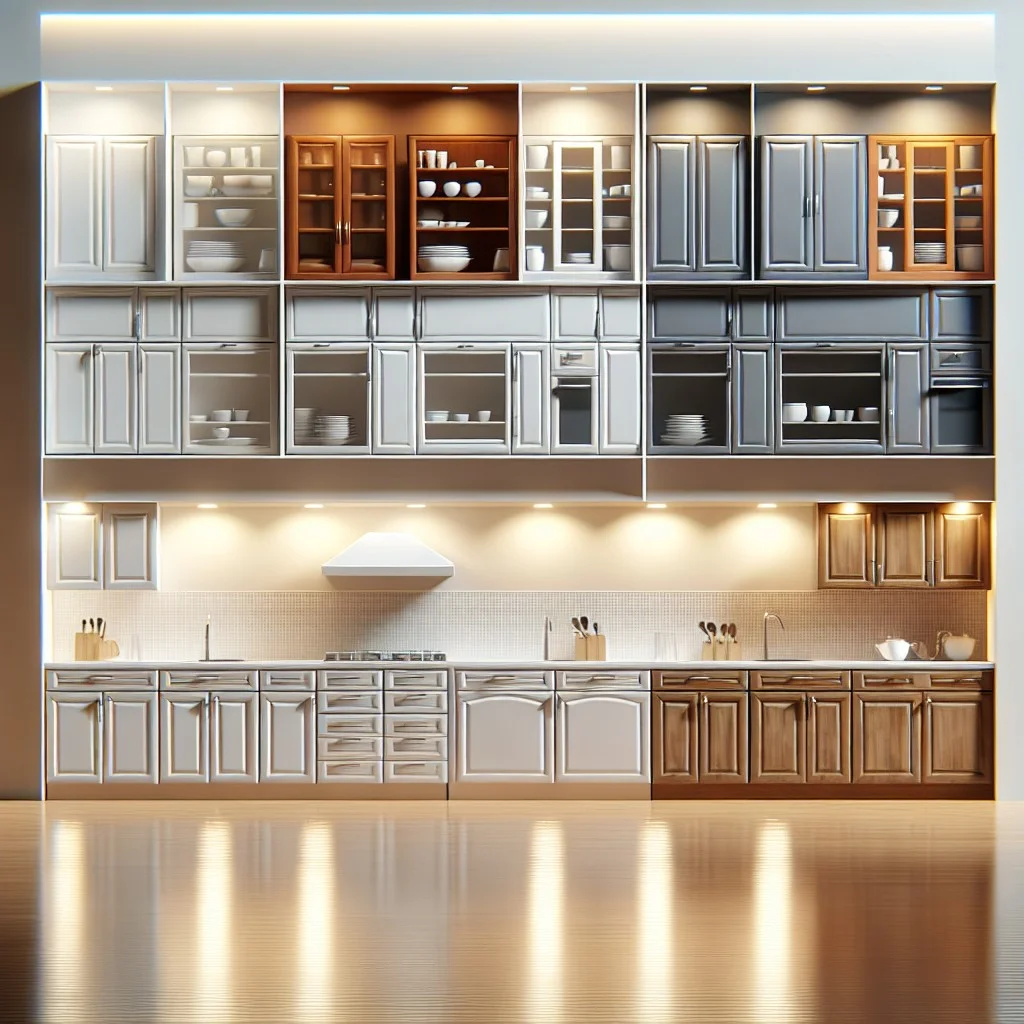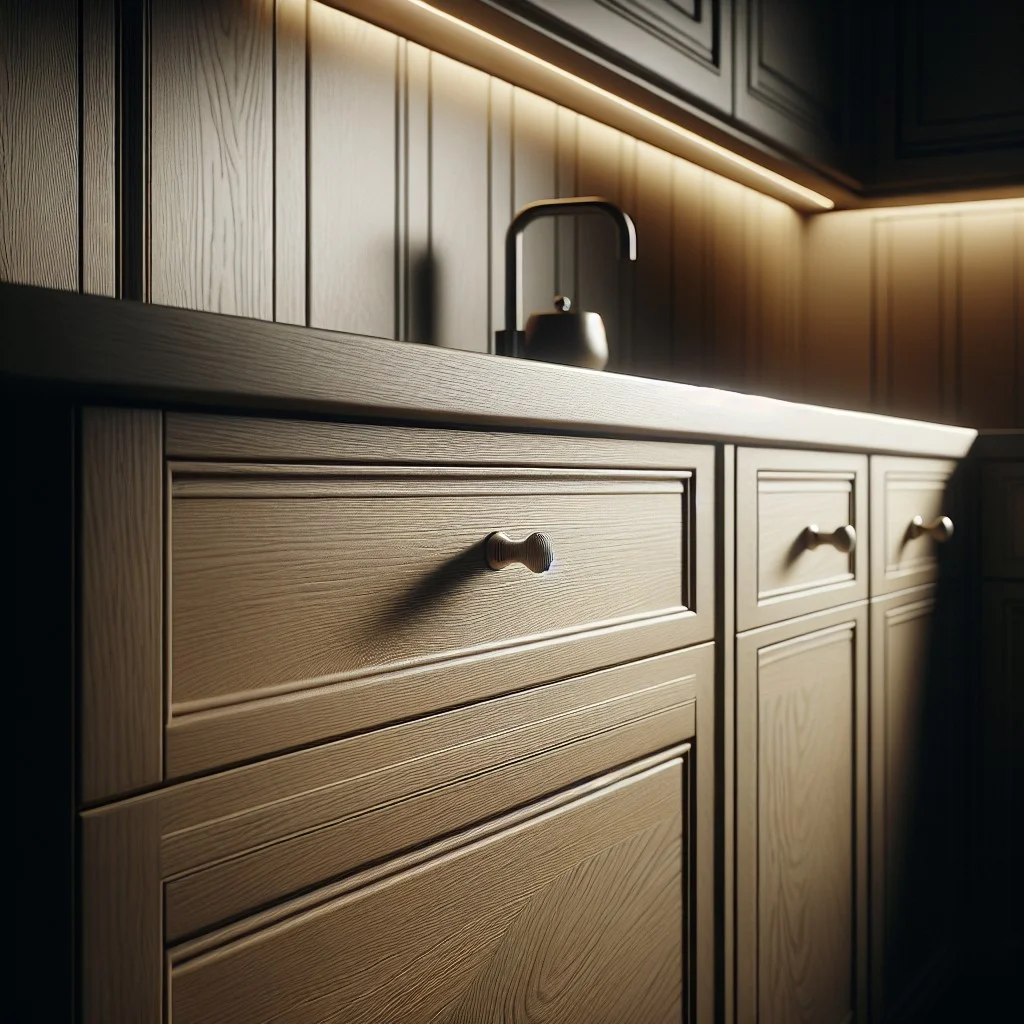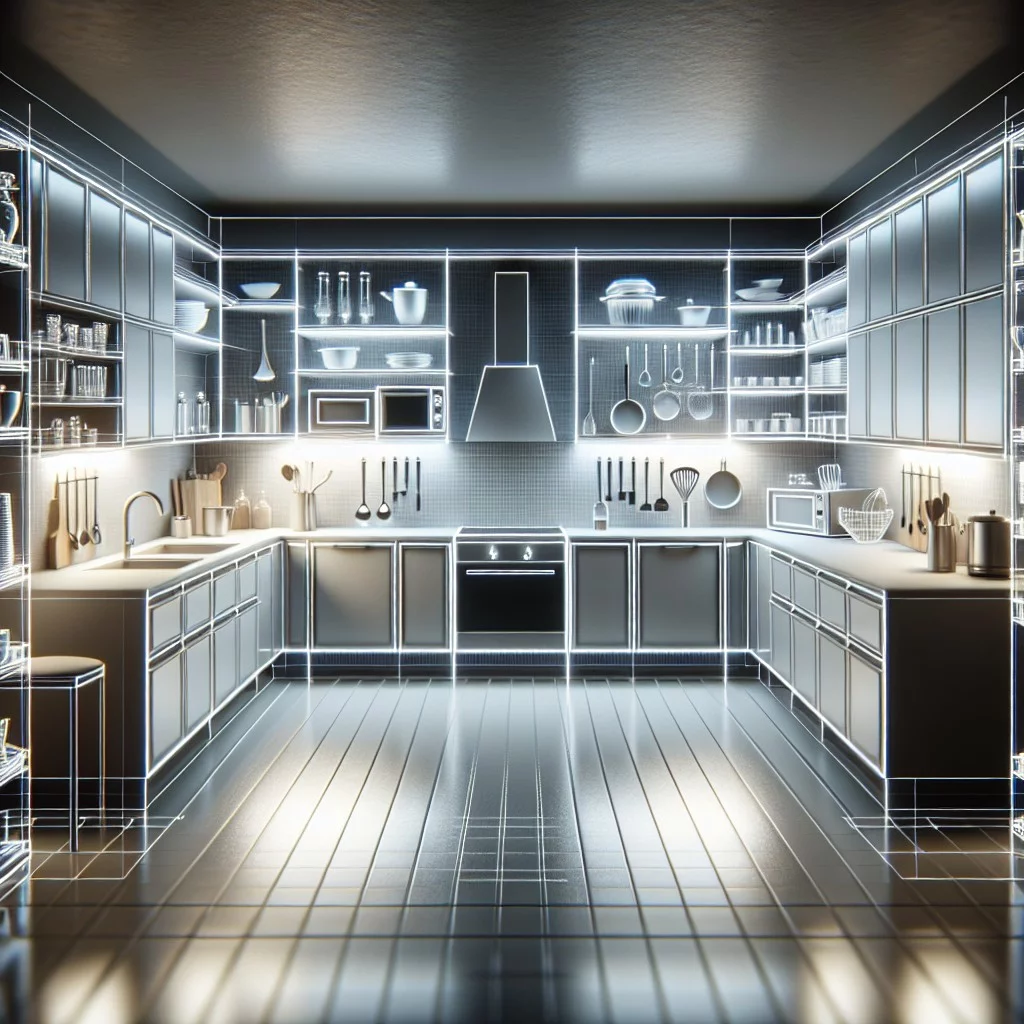Last updated on
Choosing the right sheen for kitchen cabinets dramatically transforms your culinary space because each level of gloss has its unique impact, as this comprehensive guide reveals.
Key takeaways:
- Sheen levels range from no-shine, flat matte to ultra-shiny, high gloss.
- Lower sheen levels hide imperfections well but are less durable.
- Higher sheen levels offer greater durability and ease of cleaning.
- Consider your kitchen’s lighting when choosing a sheen.
- Reflect on your kitchen’s usage—high traffic areas may benefit from a more durable, higher sheen finish.
What's Inside
Understanding Kitchen Cabinet Sheens

The sheen of kitchen cabinets refers to the finish’s glossiness level, directly impacting the look and practicality of your kitchen space. Here are several points to clarify the concept:
- Sheen levels range from no-shine, flat matte to ultra-shiny, high gloss.
- Lower sheen levels hide imperfections well but are less durable.
- Higher sheen levels offer greater durability and ease of cleaning.
- The amount of light a finish reflects increases with the sheen level.
- Consider your kitchen’s lighting when choosing a sheen, as higher glosses can create glare in well-lit or sunlit spaces.
- Reflect on your kitchen’s usage—high traffic areas may benefit from a more durable, higher sheen finish.
Understanding these points will guide you in selecting the perfect sheen that not only complements your kitchen’s aesthetics but also stands up to the demands of daily use.
Matte Sheen Characteristics

If a subdued, elegant look is what you’re after, then a matte finish might be your go-to. This sheen absorbs light, offering a smooth, even surface that hides imperfections like scratches or dents better than its glossier counterparts. It’s a favored option in contemporary or traditional designs that prioritize a classic appeal.
One should keep in mind, however, that matte surfaces can be more challenging to clean; residues and oily fingerprints tend to be more visible than on shiny finishes. Additionally, while the absence of glare makes for a sophisticated and calming aesthetic, it might not be ideal if you’re looking to brighten up your space as it doesn’t reflect as much light.
Before settling on a matte finish, weigh its stylish appearance against the practical demands of kitchen upkeep. Its chic, no-shine appearance has its appeal, but consider how it aligns with your lifestyle and the amount of traffic your kitchen cabinets will endure.
Satin Sheen: Versatility for Kitchen Cabinets

A satin sheen strikes a happy medium between matte and gloss finishes, offering a subtle sheen that’s less reflective than higher gloss options. This level of shine helps to conceal imperfections better than glossier finishes, making it a forgiving choice for high-traffic areas like a kitchen.
It’s designed for homeowners seeking a practical yet aesthetically pleasing finish. The lower level of reflection means fingerprints and smudges are less noticeable, which is ideal for busy kitchens or those with young children.
Regarding upkeep, satin offers an advantage: it cleans easily without the need for aggressive scrubbing, and it stands up well to routine washing. Furthermore, this finish has enough durability to resist the wear and tear that kitchen cabinets typically endure, including minor scrapes and scratches.
Matching with most kitchen designs is another highlight. Whether your aesthetic leans toward traditional or contemporary, the satin finish blends seamlessly, enhancing the kitchen’s visual appeal without overpowering other design elements.
Lastly, satin sheen provides a warmth that can make a kitchen feel homier and more inviting, an attribute not easily achieved with shinier finishes that tend to give off a cooler vibe.
Semi-Gloss: Balancing Shine With Durability
Semi-gloss finishes strike a happy medium between a touch of elegance and practicality. They’re known for their resilient surface that stands up to frequent cleaning, making them ideal for high-traffic areas like kitchen cabinets.
The subtle shine they offer is more forgiving than their high-gloss counterparts when it comes to showing imperfections or fingerprints. Yet, they reflect enough light to help brighten the kitchen space.
- Best for busy kitchens: Resists moisture and stains, making it suitable for homes with kids and pets.
- Easy to clean: Smooth finish allows for simple wipe-downs with a damp cloth.
- Moderate reflection: Offers a light-reflective surface that contributes to a brighter kitchen without being overwhelming.
- Hides imperfections: Less prone to highlighting dings and scratches compared to higher sheens.
High-Gloss: A Statement in Modern Kitchens
High-gloss finishes bring an undeniable energy to modern kitchen spaces. This sheen reflects light powerfully, amplifying the brightness of the area, and works wonders in dark or smaller kitchens, giving the illusion of a larger space. Its sleek surface is synonymous with contemporary design, offering a clean, streamlined look that pairs elegantly with minimalist aesthetics.
There’s more to this lustrous choice than meets the eye. It can also enhance the vibrancy of cabinet colors, making hues pop and capturing the gaze of anyone who enters the room. However, it’s worth noting that high-gloss surfaces might show fingerprints and smudges more readily. This means you’ll be committing to a bit more upkeep to maintain that pristine finish.
If you’re leaning towards a futuristic or ultra-modern kitchen atmosphere, this sheen might just be your perfect match. Just ensure you’re up for the regular maintenance to keep those reflective surfaces looking flawless.
Factors to Consider When Choosing Cabinet Sheen
Before making your decision, here are essential factors to weigh:
- Kitchen Lighting: The amount of natural and artificial light in your kitchen will influence how your cabinets look. Brightly lit spaces can handle matte finishes, while less lit areas may benefit from the reflectiveness of glossier options.
- Daily Usage: Think about how you use your kitchen. High-traffic kitchens might need a durable, easy-to-clean finish like semi-gloss, which stands up well against frequent wiping and touch-ups.
- Aesthetic Goal: Envision the end result. If you’re aiming for a contemporary vibe, a high-gloss finish could be fitting. For a traditional or rustic style, matte or satin might be more suitable.
- Size of the Kitchen: The sheen can influence the perception of space. Glossy cabinets can make a small kitchen feel larger due to their reflective qualities.
- Imperfections: If your cabinets have dings or scratches, a lower sheen can help hide these imperfections more effectively than a shinier finish.
Considering these factors will guide you toward a sheen that not only looks great but also fits the practical needs of your everyday kitchen use.
Durability and Longevity of Cabinet Finishes
Selecting the appropriate sheen for kitchen cabinets significantly influences their resilience. A higher gloss finish tends to offer greater durability, ideally suited to the high-traffic environment of a kitchen. Here’s why:
- Resistance to Damage: Surfaces with glossier finishes are more resistant to scratches and nicks. The reflective quality means minor imperfections are less noticeable, and the harder finish provides a protective barrier.
- Ease of Cleaning: Kitchens are prone to splatters and stains. Semi-gloss and high-gloss surfaces allow you to easily wipe away grime without damaging the paint or wood underneath.
- Moisture Repellency: The kitchen is a humid environment. A higher sheen finish repels moisture more effectively, preventing the wood from warping and paint from peeling.
- Color Retention: Over time, finishes can yellow or fade. Glossier sheens are less susceptible to discoloration, helping cabinets retain their vibrant color for longer.
Consider how these factors align with your kitchen’s functionality and daily use, keeping in mind that the right balance between practicality and aesthetic preference will yield the best long-term satisfaction.
Maintenance and Cleaning Requirements
When it’s time to tackle the inevitable kitchen mess, different sheens respond differently to scrubbing and cleaning. Matte finishes, while elegant and contemporary, may require more effort to clean and can show smudges and fingerprints more readily. Gentle, non-abrasive cleaners are your best bet to keep them looking sharp without damaging the finish.
On the flip side, higher gloss finishes such as semi-gloss or high-gloss make wiping away stains and spills a breeze. Their slick surface allows for easier maintenance, with most messes requiring just a simple swipe of a damp cloth. However, they might highlight imperfections and require consistent cleaning to maintain their shine.
Consider your household’s activity level—homes with children or frequent cooking may benefit from the durability and low-maintenance of shinier finishes. For a balance between easy maintenance and a soft aesthetic, satin finishes offer a happy medium and hide imperfections better than their glossier counterparts.
Reflective Qualities of Different Sheens
Sheen levels on kitchen cabinets dramatically influence how light interacts with the surface. Matte finishes absorb light, providing a non-reflective, smooth appearance that can help hide imperfections. Satin sheens offer a subtle glow, making them forgiving with light and less prone to showing smudges and fingerprints. They provide a warm ambiance without overwhelming glossiness.
On the other hand, semi-gloss finishes reflect more light, which can brighten the kitchen space and make it appear larger. However, they are more likely to highlight surface imperfections. High-gloss finishes are the most reflective, creating a mirror-like effect that maximizes light distribution. This option is ideal for ultra-modern kitchens but requires meticulous maintenance as it shows dirt and scratches more readily.
When factoring in the lighting of your kitchen, whether it’s natural or artificial, consider how these varying levels of sheen will interact with it. For instance, a highly lit kitchen with lots of windows could benefit from lower sheen levels to reduce glare, whereas a kitchen with weaker lighting might welcome the brightness of a semi-gloss finish.
Matte Vs. Satin Vs. Semi-Gloss Vs. High-Gloss: Comparing Finishes
When choosing between matte, satin, semi-gloss, and high-gloss for kitchen cabinets, consider these points:
- Matte sheen absorbs light, creating a non-reflective surface ideal for concealing imperfections and complementing a traditional or rustic kitchen aesthetic.
- Satin sheen, being slightly more reflective, offers a good balance of warmth and easy-to-clean surfaces, making it well-suited for most kitchens.
- Semi-gloss, with higher reflectivity, stands up well against moisture and is easier to clean, which is recommended for kitchens with extensive usage or in homes with children.
- High-gloss finishes deliver a brilliant, sleek look and are resistant to moisture, though they tend to highlight surface imperfections and require more frequent cleaning to maintain their shine.
Each finish has its unique benefits and drawbacks, so the decision should align with your lifestyle needs, design preferences, and the amount of traffic your kitchen cabinets will endure.
Tips for Choosing the Right Sheen for Your Kitchen Style
Reflect your kitchen’s personality by aligning cabinet sheen with the room’s overall aesthetic. Traditional and rustic kitchens benefit from the softness of matte or satin finishes, subtly complementing natural materials like wood.
For contemporary spaces, semi-gloss or high-gloss cabinets contribute to a sleek, clean appearance, reflecting light and enhancing the modern vibe.
Consider the following points to ensure harmony between cabinet sheen and kitchen style:
- Color Scheme Compatibility: Lighter colors tend to be forgiving with lower sheens, while darker hues can be striking with a higher gloss level.
- Lighting Conditions: Rooms with ample natural light or strong artificial lighting pair well with lower sheens to reduce glare. However, a high-gloss finish can brighten a kitchen with less light.
- Visual Space Enhancement: Small kitchens benefit from higher sheen levels, which can make the space appear larger due to their reflective properties.
- Architectural Details: Highlight architectural features with a contrasting sheen. Use a higher gloss on cabinets to draw attention or a matte finish to downplay them.
By integrating these considerations, you’ll enhance both the function and fashion of your kitchen through a well-chosen cabinet sheen.
Maximizing Small Kitchens With Sheen Choices
Selecting the right sheen for your kitchen cabinets can give the illusion of a larger space, which is particularly important in smaller kitchens. A higher sheen level can help reflect light around the room, enhancing brightness and creating a sense of openness. However, it’s essential not to go overboard as highly reflective surfaces can also highlight imperfections.
Here are some points to consider:
- Satin finishes are often recommended, as they combine the benefits of light reflection with a lower risk of showing smudges and fingerprints, which can be emphasized in small spaces.
- Reflective backsplashes can be paired with semi-gloss cabinets for a coherent look that amplifies light without overwhelming the space with shine.
- Opting for lighter color paints with a hint of sheen can make the kitchen appear airier, while darker hues tend to absorb light and might be better with a matte finish to soften the effect.
- Vertical patterns or lines in the cabinet design can draw the eye upward, making the ceilings seem taller and the space larger, especially when coupled with a subtle sheen.
- Be mindful of kitchen lighting; under-cabinet lighting paired with the right sheen can significantly impact the perceived size of the kitchen.
By striking the correct balance, you can create a welcoming kitchen that feels both cozy and spacious.
Protecting Cabinets From Humidity and Temperature Changes
Kitchens are high-humidity environments, and cabinets must endure the stress of temperature fluctuations. To safeguard your investment:
1. Select a finish that stands up to moisture. Semi-gloss and high-gloss options typically offer the best barrier against humidity by preventing water vapor from penetrating the wood.
2. Ensure proper ventilation in the kitchen. Using exhaust fans helps regulate moisture levels, reducing the risk of cabinet warping or damage.
3. During temperature transitions, gradual acclimatization of the wood helps. Avoid sudden heat changes which can cause the wood to expand or contract too quickly, leading to cracks.
4. Apply a sealant as an extra layer of protection on top of the paint sheen, particularly in areas close to the sink or stove, where exposure to water and heat is frequent.
5. Consider the materials. Some woods are more resistant to humidity and temperature shifts; discuss options with a professional, especially if you’re considering custom cabinetry.
Maintaining a stable environment can extend the life and beauty of your kitchen cabinets, ensuring that they remain a functional and aesthetic centerpiece in your home for years to come.
Professional Paint Recommendations for Kitchen Cabinets
When consulting with professionals about paint for kitchen cabinets, you’ll find they often have their favored products and approaches. Here’s what you might hear:
1. Quality Over Cost: Pros recommend investing in top-tier acrylic or oil-based paints because they offer superior durability and a smoother finish.
2. Primer is Key: A high-quality primer is essential for ensuring paint adherence and creating a flawless base, especially when transitioning from a darker to a lighter color.
3. Self-Leveling Paints: These paints minimize brush strokes and provide a uniform finish, which is crucial for cabinets, as they’re at eye level and imperfections are more noticeable.
4. Hard Finish Paints: Look for terms like “enamel” or “industrial” in paint types to find products that dry harder and are more resistant to wear and tear.
5. Spray Application: While it’s a more complex technique requiring specialized equipment and skills, spraying offers the most professional-looking result void of brush marks.
6. Tinted Clear Coats: For an extra layer of protection without altering the color, professionals might suggest a clear topcoat that’s been slightly tinted to enhance the cabinet’s finish.
By taking into account these professional insights, selecting paint for kitchen cabinets can lead to a high-quality finish that withstands the demands of a busy kitchen environment.
FAQ
What is the most common sheen for kitchen cabinets?
The most common sheen for kitchen cabinets is semi-gloss due to its moderate level of gloss, ease of maintenance, and ability to add depth and dimension to the cabinets.
Should cabinets be gloss or satin?
For durability and ease of cleaning in high-use areas like kitchens, gloss finish is the recommended choice for kitchen cabinets.
What is best paint for kitchen cabinets?
The best paint for kitchen cabinets is oil-based paint due to its durability and hard-drying properties which resist wear and tear.
What is the most popular finish for kitchen cabinets?
The most popular finish for kitchen cabinets is typically semi-gloss.
How does the sheen level affect the durability of kitchen cabinets?
The sheen level of paint affects the durability of kitchen cabinets by determining the ability to resist scratches, stains, and wear; generally, the higher the sheen, the greater the durability.
What factors should I consider when choosing the sheen for kitchen cabinets?
When choosing the sheen for kitchen cabinets, consider factors such as the level of daily use, the style of your kitchen, the desired ease of cleaning, and the potential for showing cracks or imperfections.
What are the pros and cons of matte versus high gloss finishes for kitchen cabinets?
Matte finishes for kitchen cabinets offer a contemporary look, hide scratches, and require less cleaning, whereas high gloss finishes reflect light, creating a brighter space, but show scratches and smudges easily.




